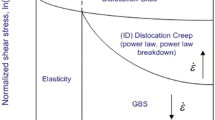Abstract
This study examines the performance of four constitutive models according to capacity in predicting metal fatigue life under proportional and non-proportional loading conditions. These cyclic plasticity models are the multi-surface models of Mroz and Garud, and the non-linear kinematic hardening models of Armstrong-Frederick and Chaboche. The range of abilities of these models is studied in detail. Furthermore, the plastic strain energy under multiaxial fatigue condition is calculated in the cyclic plasticity models by the stress-strain hysteresis loops. Using the results of these models, the fatigue lives that have set in the energy-based fatigue model are predicted and evaluated with the reported experimental data of 1% Cr-Mo-V steel in the literature. Consequently, the optimum model in the loading condition for this metal is chosen based on life factor.
Similar content being viewed by others
References
B. R. You and S. B. Lee, A critical review on multiaxial fatigue assessments of metals. International Journal of Fatigue, 18(4) (1996) 235–244.
A. Fatemi and D. F. Socie, Critical plane approaches to multiaxial fatigue damage including out-of-phase loading. Fatigue & Fracture of Engineering Materials & Structures, 11(3) (1988) 149–165.
E. Macha and C. M. Sonsino, Energy criteria of multiaxial fatigue failure. Fatigue & Fracture of Engineering Materials & Structures, 22 (1999) 1053–1070.
I. V. Papadopoulos, P. Davoli, C. Gorla, M. Fillippini and A. Bernasconi, A comparative study of multiaxial high-cycle fatigue criteria for metals. International Journal of Fatigue, 19(3) (1997) 219–235.
D. H. Kwak, H. R. Roh, J. K. Kim and S. B. Cho, A study on fretting fatigue life prediction for Cr-Mo Steel (SCM420). Journal of the Korean Society of Precision Engineering, 24(4) (2007) 123–130.
G. Rashed, R. Ghajar and G. Farrahi, Multiaxial stress-strain modeling and effect of additional hardening due to nonproportional loading. Journal of Mechanical Science and Technology, 21(8) (2007) 1153–1161.
H. J. Gough, Engineering steels under combined cyclic and static stresses. Journal of Applied Mechanics, 50 (1950) 113–125.
Y. Yokobori, H. Yamanouc and S. Yamamoto, Low cycle fatigue of thin-walled hollow cylinder specimens of mild steel in uniaxial tests at constant strain amplitude. International Journal of Fracture Mechanics, 1 (1965) 3–13.
C. E. Feltner and J. Morrow, Microplastic strain hysteresis energy as a criterion for fatigue fracture. Journal of Basic Engineering, Transactions of the ASME, Series D, 83 (1961) 15–22.
J. Morrow, Cyclic plastic strain energy and fatigue of metals. Internal friction, damping and cyclic plasticity, ASTM STP 378, American Society for Testing and Materials, West Conshohocken, PA, (1965) 45–87.
G. R. Halford, The energy required for fatigue. Journal of materials, 1(1) (1996) 3–18.
H. Jahed and A. Varvani-Farahani, Upper and lower fatigue life limits model using energy-based fatigue properties. International Journal of Fatigue, 28 (2006) 467–473.
M. Haffman and T. Seeger, A generalized method for estimating multiaxial elastic-plastic notch stresses and strains, part1. Journal of Engineering Materials and Technology, 107 (1985) 250–254.
D. McDowell, An evaluation of recent developments in hardening and flow rules for rate-independent, nonproportional cyclic plasticity. ASME, Journal of Applied Mechanics, 54 (1987) 323–334.
Y. Dafalias and E. Popove, Plastic internal variables formalism of cyclic plasticity. ASME. Journal of Applied Mechanics, 43 (1975) 645–651.
S. Bari and T. Hassan, Kinematic hardening rules in uncoupled modeling for multiaxial ratcheting simulation. International Journal of Plasticity, 17 (2001) 885–905.
W. Prager, A new method of analyzing stresses and strains in work hardening. Journal of Applied Mechanics, 23 (1956) 493–496.
P. J. Armstrong and C. O. Frederick, A mathematical representation of the multiaxial Bauschinger effect. G.E.G.B. Report RD/B/N731, Berkeley Nuclear Laboratories, (1966).
J. L. Chaboche, Time-independent constitutive theories for cyclic plasticity. International Journal of Plasticity, 2(2) (1986) 149–188.
J. L. Chaboche, Constitutive equations for cyclic plasticity and cyclic viscoplasticity. International Journal of Plasticity, 5(3) (1989) 247–302.
J. L. Chaboche, On some modifications of kinematic hardening to improve the description of ratchetting effects. International Journal of Plasticity, 7(7) (1991) 661–678.
Z. Mróz, On the description of anisotropic work-hardening. Journal of the Mechanics and Physics of Solids, 15 (1967) 163–175.
Z. Mróz, An attempt to describe the behavior of metals under cyclic loads using a more general workhardening model. Acta Mechanica, 7(2) (1969) 199–212.
Y. S. Garud, Multiaxial fatigue: a survey of the state of the art. Journal of Testing and Evaluation, 9 (1981) 165–178.
J. Yanyao, O. W. Christian, V. Michael and N. Horst, Fatigue life predictions by integrating EVICD fatigue damage model and an advanced cyclic plasticity theory. International Journal of Plasticity, 25(5) (2009) 780–801.
D. Lohr, R. and E. G. Ellison, Biaxial high strain fatigue testing of 1% Cr-Mo-V steel. Fatigue of Engineering Materials & Structures, 3 (1980) 19–37.
K. Kanazawa, K. J. Miller and M. W. Brown, Cyclic deformation of 1% Cr-Mo-V steel under out-of-phase loads. Fatigue of Engineering Materials & Structures, 2 (1979) 217–228.
M. W. Brown, K. J. M., Biaxial cyclic deformation behaviour of steels. Fatigue of Engineering Materials & Structures, 1 (1979) 93–106.
Author information
Authors and Affiliations
Corresponding author
Additional information
This paper was recommended for publication in revised form by Associate Editor Chongdu Cho
Shahram Shahrooi received his B.S. and M.S. degrees in Mechanical Engineering from the Islamic Azad University, Arak branch, Iran, in 1991 and 1996, respectively. At present, he is a Ph.D. student at the Department of Mechanical Engineering at the University of Malaya, Kuala Lumpur, Malaysia. Mr. Shahrooi’s research interests include fatigue, plasticity, and finite element method.
Ibrahim Henk Metseelar earned his M.S. degree in Chemical Technology from the University of Twente in the Netherlands in 1994. During his Ph.D. studies in Mechanical Engineering, his research focus was Tribology. Dr. Metseelar joined the University of Malaya in September 2001 and has worked as Senior Lecturer in the Materials program in the Mechanical Engineering Department.
Rights and permissions
About this article
Cite this article
Shahrooi, S., Metselaar, I.H. & Huda, Z. Evaluation of cyclic plasticity models of multi-surface and non-linear hardening by an energy-based fatigue criterion. J Mech Sci Technol 24, 1255–1260 (2010). https://doi.org/10.1007/s12206-010-0339-y
Received:
Revised:
Accepted:
Published:
Issue Date:
DOI: https://doi.org/10.1007/s12206-010-0339-y




